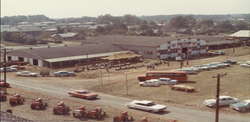Winston-Salem Fairgrounds
 From Wikipedia the free encyclopedia
From Wikipedia the free encyclopedia
 | |
| Location | |
|---|---|
| Time zone | UTC−05:00 |
| Capacity | over 7,000 |
| Opened | 1929 (exclusively for horses and motorcycles)[3] July 5, 1948 (for stock car racing)[4] |
| Major events | SAFE Convertible[4] NASCAR Modified[4] Grand National Series[4] |
| Dirt oval track[2] | |
| Length | 0.500 miles (0.805 km) |
| Turns | 4 |
| Race lap record | 59.016 miles per hour (94.977 km/h) (Lee Petty, Petty Enterprises, August 7, 1955, NASCAR Grand National Series) |
The Winston-Salem Fairgrounds (previously known as the Dixie Classic Fairgrounds)[3] was a dirt oval track spanning 0.500 miles (0.805 km)[2] in addition to its primary purpose as a fairground. During the times of the year that it wasn't expected to host a stock car race, this fairground was the home of the annual Winston-Salem Fair/Dixie Classic Fair for Northwest North Carolina[5] along with other events related to the Piedmont Triad area of North Carolina. The annual fair would traditionally take place in the first week of October.[5] On December 1, 1969, the Winston-Salem Foundation gave the Fairgrounds, the Memorial Coliseum, and $75,000 to the City of Winston-Salem.
Racing history
[edit]
The race track component of the fairgrounds was used primarily for NASCAR-style stock car racing and was discarded by the Grand National Series after their 1955 season.[2] Most of the races took place on either the summer or early autumn months; although one race took place after what is now called the Dixie Classic Fair (October 31, 1948).[4]
Lee Petty won both the May 29 and August 7 unnamed Grand National Series races on this race course.[1][2][4][6] Fred Dove would be notable for participating in his last NASCAR Cup Series career race on this track; he would finish in third place out of 23 competitors. Outside of the Cup Series, Fonty Flock (in his NASCAR modified vehicle), Curtis Turner (driving in a stock car race that preceded the NASCAR Cup Series), and Jack Harrison (driving in the SAFE Convertible Series) would win races at this ½-mile dirt oval.[4] The SAFE (Society of Auto Sports, Fellowship, and Education) Convertible Series would eventually be bought out by NASCAR to become the NASCAR Convertible Division in 1955.[7] However, even the NASCAR Convertible Series would be short-lived and become permanently disbanded after 1959.[8] This was due to the fact that multiple sedan passenger automobiles could race on the track much more safely with the increasingly faster speeds than their convertible counterparts.
Both of the Cup Series races spanned 100 miles (160 km) and the most expensive purse was $3,765 ($42,822.78 when adjusted for inflation).[1] Driving speeds of up to 59.016 miles per hour (94.977 km/h) could be sustained on this race track through single-car qualifying.[2] When all cars were on the track, the fastest average speed would be reduced to 50.583 miles per hour (81.405 km/h).[2] The speeds are considered to be slightly inferior to the typical modern highway which can sustain speeds up to 110.000 kilometres per hour (68.351 mph). Races would typically last less than two hours;[2] with the longest race lasting one hour, fifty-nine minutes, and forty-four seconds.[9]
All forms of automobile racing was discontinued on this track after 1963. The fate of motorcycle and horse racing on the track were left uncertain after the stock cars stopped racing in this venue.
References
[edit]- ^ a b c Everything Stock Car - Forsyth County Fairgrounds
- ^ a b c d e f g h Racing Reference - Forsyth County Fairgrounds - General information
- ^ a b Google Documents - Early NASCAR History 1940-1958
- ^ a b c d e f g Ultimate Racing History - Forsyth County Fairgrounds
- ^ a b The Dixie Classic Fair History (Internet Archive)
- ^ mcubed.net - NASCAR - Forsyth County Fairgrounds
- ^ Bob Pronger - Biography; Stan Kalwasinski; Chicagoland Auto Racing, Retrieved October 24, 2010
- ^ Coulter, Bill (1998). Building and Detailing Scale Model Stock Cars. Kalmbach Publishing, Co. p. 5. ISBN 0-89024-285-2.
- ^ Racing Reference - Untitled August 7, 1955 Race